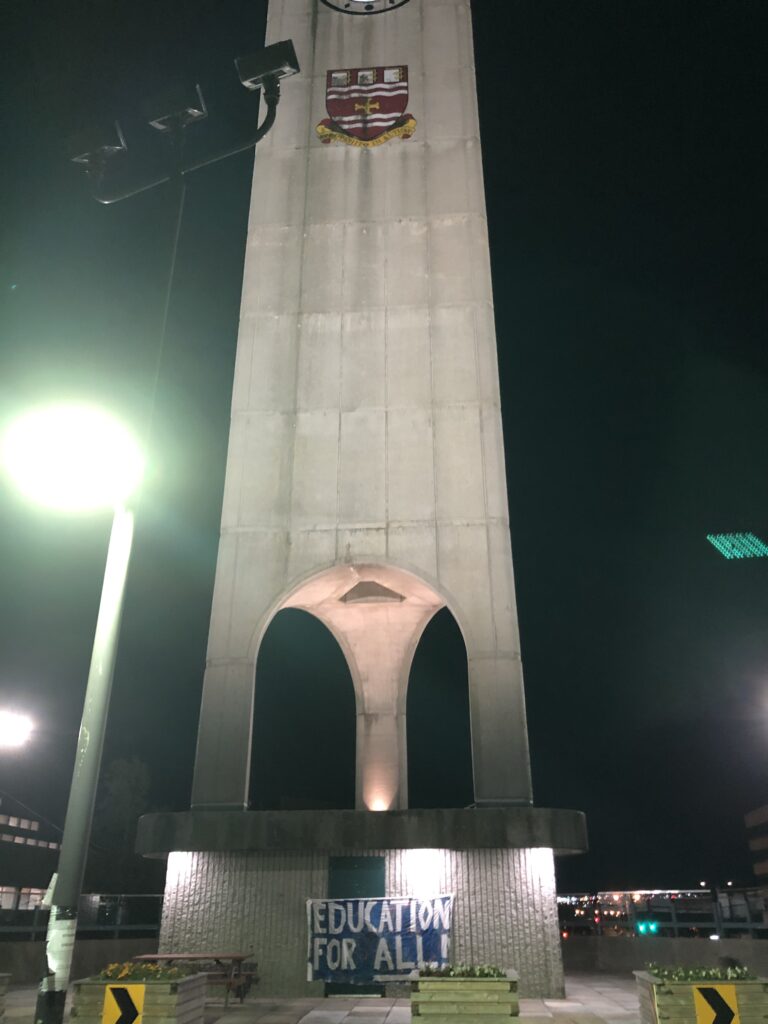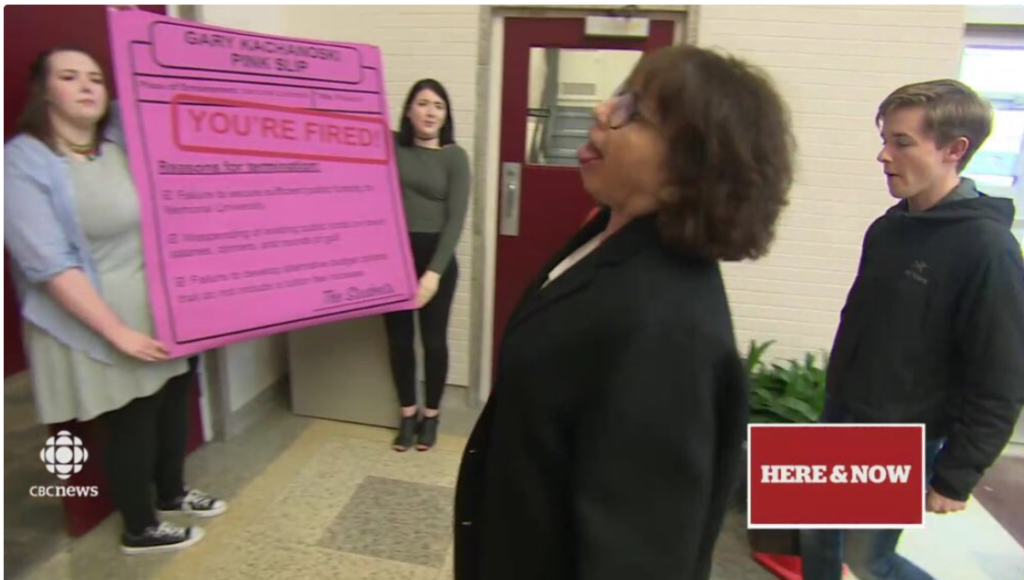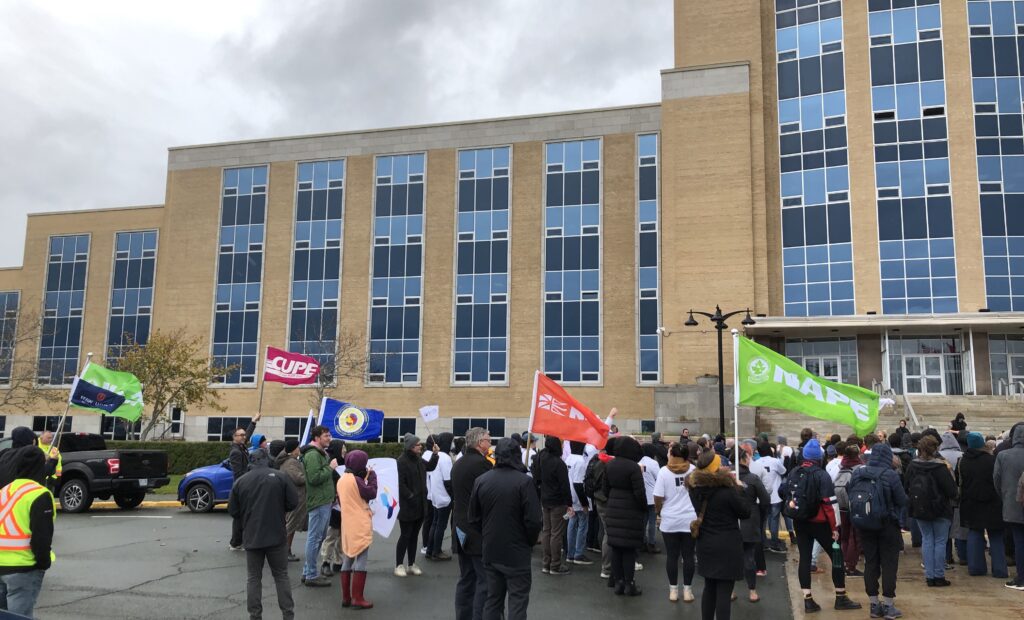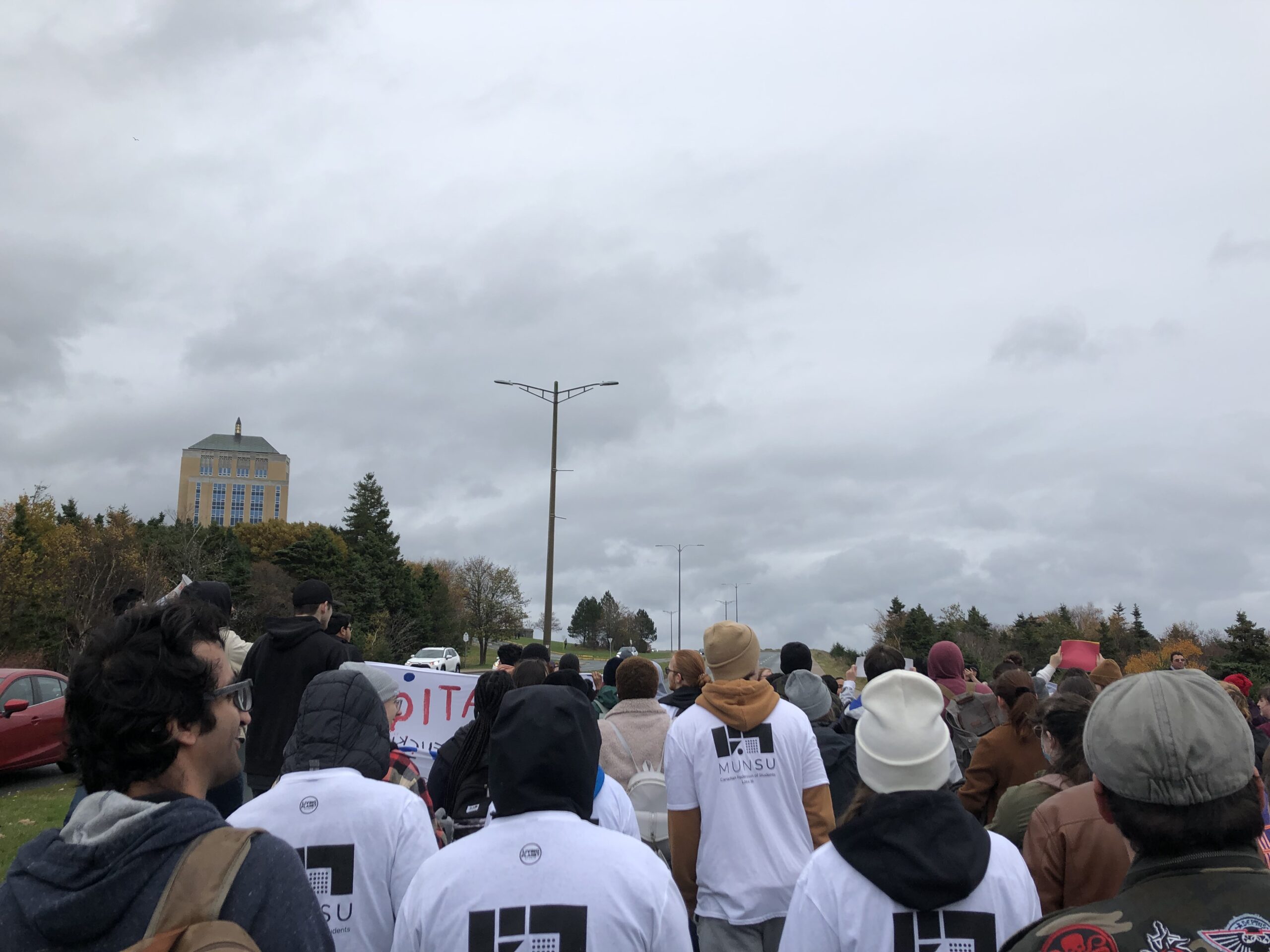“All Out Like 99” was a special event. On the afternoon of Nov 2nd, several hundred students occupied the front steps of the Confederation Building after having marched nearly two kilometres through multiple lanes of traffic on Prince Phillip Drive.
The crowd built quickly at the steps of the University Centre, in front of the clocktower, where a war banner remained long after the event, somewhat ominously.

Although it initially stood as a small crowd, the gathering rapidly grew to an innumerable one, representing the general student body- for the most part. What was more curious about the event was how syncretic its justifications and broad its goals seemed. While, in one sense, this is a criticism of the campaign itself- it was also one of its most vital organizing strengths.
I’ve been a representative on the MUNSU Board of Directors two times now, and I remember a time before my terms- when the “Fund the Future” Rally of 2019 struggled to amass seventy-five people. This was not that rally.
That was an era when the U-PASS vote failed– for varying reasons still discussed to this day. Before COVID-19, the student discourse focused on Former premier Dwight Ball and Dr. Noreen Golfman, Memorial’s former provost and academic vice president. She famously stuck her tongue out at protestors of tuition increases. MUNSU also faced challenges as they were over-encumbered with a high likelihood of tuition hikes and a demobilized generation of students indifferent about high tuition rates impacting students arriving after them.

Those affected students, who have since arrived following the chaotic “post-COVID” years of off-campus learning, and dorm closures- have finally landed on campus. They are not happy.
MUN’s COVID generation & international student challenges
If you look at current MUN students who graduated high school in 2020 (following that underwhelming February rally)- they missed prom, graduation, MUN orientation, frosh, in-person classes, extracurriculars, and a slightly less hellish housing market upon their arrival to St. John’s.
These same individuals have been reintroduced to post-secondary education, knowing full well that the pandemic was ongoing. While their rent and inflation rates increased, minimum-wage student jobs were rendered even less valuable.
Even though many young frontline workers are considered “essential” upon returning to class, many are beginning to wonder if their leaders really care or whether they truly listen to their needs as they work longer hours for fewer wages.
As fewer students turn to MUN for affordable education, the number of international students at MUN is rising sharply– perhaps the most exploited sector of this university’s population. Their voiced mistreatment at the rally may be remembered by MUN decades from now- with shame. In this context, one of the frontline banners at the march read: “MAKE MIGRANT JUSTICE A LABOUR ISSUE.”
Despite working in many essential roles in our community and engaging with full-time studies, many international students also face discrimination as minorities, provincially and nationally. On top of this, they pay the most of anyone at the university for the same education. The tuition rates are higher because of nationality, over which they have no control- similar to those born in Newfoundland & Labrador, who pay the lowest tuition rates (compared to Canadians from out of the province). The new tuition rate for international students stands at $2,000 per course, or 10,000 per semester for a full course load- $20,000 in tuition fees for a Fall and Winter enrolment.
The issue worsens when you consider that many international students admire Canada and actively seek permanent residency. This dynamic means they swim upstream due to treatment by their increased tuition. It is a nationality tax.
Many argue it is justified because these individuals have not paid taxes to the government before enrolling at MUN. How many Canadians have paid any significant taxes before enrolling in university? Many are 18 when they first study and have only held part-time jobs.
This is completely aside from the fact that many international students are employees in positions that the labour shortage urgently needed to be filled- only for their wages to become syphoned into this draconian nationality tax. Nobody should be surprised that the food banks are empty- particularly Loblaws, as many large grocery conglomerates have allegedly driven up the cost of living by taking advantage of price fixing.
Only last month, CBC’s The Fifth Estate aired a special episode on the “false promises” used to recruit students from India to Canada. Many of these students study at more expensive schools, work full-time, and rely on the financial support of their families. The outcomes have been fatal, and the consequences of this system are already irreversible to some.
International student pressures illustrate a reality where a bad semester becomes a financial tragedy- a mistake many domestic students can afford. The grim conditions have led to a dark reality of strained mental health for international students who face unique obstacles on top of the challenges already facing the COVID generation. Despite holding their end of the (unbalanced) bargain, President Vianne Timmons and fellow leadership at MUN have been unrelenting and committed to increasing their tuition rates.
One international student who spoke on the Confederation steps stated that his ambitions to immigrate to Newfoundland were motivated by an admiration for the province and its heritage- which specifically included its historical support for MUN and its students:
“They are taking away our Newfoundland heritage that we are proud of… Please protect the heritage that has been providing for Newfoundlanders for so many years.”
An open-mic speaker, and concerned international student
Clouds over Confederation, mobs at the door
Likely burrowed away somewhere from MUNSU’s dominating presence last week was Premier Andrew Furey. In his own eyes, he is only accountable to the provincially eligible voters (of which many students are not, unfortunately). His disinterest in supporting the university and maintaining the tuition freeze only comes across as callous.
I like to imagine that at some point, he might’ve looked out his window (if he was even there that afternoon) and wondered why people were upset. It wouldn’t’ve been hard to figure out, given all the banners, flags, and signs listing obvious and apparent problems where leaders and institutions have failed the public. Perhaps the call for inspiring democratic leadership is too much to ask for now.
He would’ve either listened- or ignored demands. Maybe he outright ignored us entirely and carried on business as usual.
When various students took the stage and vulnerably shared their extensive burdens faced by mounting pressures on youth workers, students, and international students- did he think we were all lying? Or did he politely disagree that we needed help? Maybe for a moment, he realized that he couldn’t help us- without compromising on an unpopular neoliberal program, deadset on austerity.
He once remarked that he changed from surgery to politics due to “a want and desire to do more.” However: far more have far less, and public dissatisfaction seems to be the only thing growing.
As some critics have pointed out, the $500 relief deposits en route to anyone earning less than $125k was a more expensive policy than simply maintaining the tuition freeze. This decision would not have sent money to those financially comfortable despite inflation. The subtext is highly political and reeks of the 2021 federal election and the CERB impact on polling. Furey shows his cards in political strategy with no apology by directly paying upper-middle-class taxpayers, subsequently abandoning and galvanizing youth against him.
So what was it about?
We are at a unique point in this province’s history (which mimics the national and international trends). The economy and political system have garnered significant dissatisfaction from an unheard youth- many would leap at the opportunity to stand at the foot of the provincial parliament to make their demands heard. One clear frustration, aside from the tuition hikes, was the rising cost of living.
It’s difficult to realize that there will be an entire generation whose formative adult memories showcase the dire political instability of the status quo and the impotence of traditional leadership.
What is beginning to take shape is a political sentiment extending beyond the veil of just MUN’s bureaucracy, including higher powers in its reproach- as so many attendees connected on shared struggles in a system lacking real democracy, their own lives are confronted by a corroding material reality they’ve inherited. In a time of failed leadership, solidarity is rematerializing between old forgotten forces of activism. It was seen in the faces of upset youth, education workers, labour union members, immigrants, and more.
The appearance of many vital labour unions from the area in support of MUNSU was remarkable. NAPE, MUNFA, CUPE, Registered Nurses’ Union and even the NDP, headed by NLNDP leader Jim Dinn, were flying flags in their march on the Confederation Building. In this respect, one could arguably see a social democratic tinge to the rally.

After assembling in a highway phalanx that strode through sectioned-off traffic, the students were cheered by commuters and commercial truck drivers. It was clear how we might be received when a Heave Away waste removal rig blared its horn shortly after we turned onto Prince Phillip Drive.
The Confederation Building’s glass doors were locked when we finally mounted the front steps. It was perfect symbolism. We knew exactly what kind of decisions were being made in our community by political leadership- we could literally look inside the building where the sausage was made. We just weren’t allowed to get anywhere near it. There was no way they couldn’t hear us- they just didn’t seem to care very much.
The uncertainty of our school’s future is how the government (and, more importantly, the rejected protestors) will respond to growing anger.



